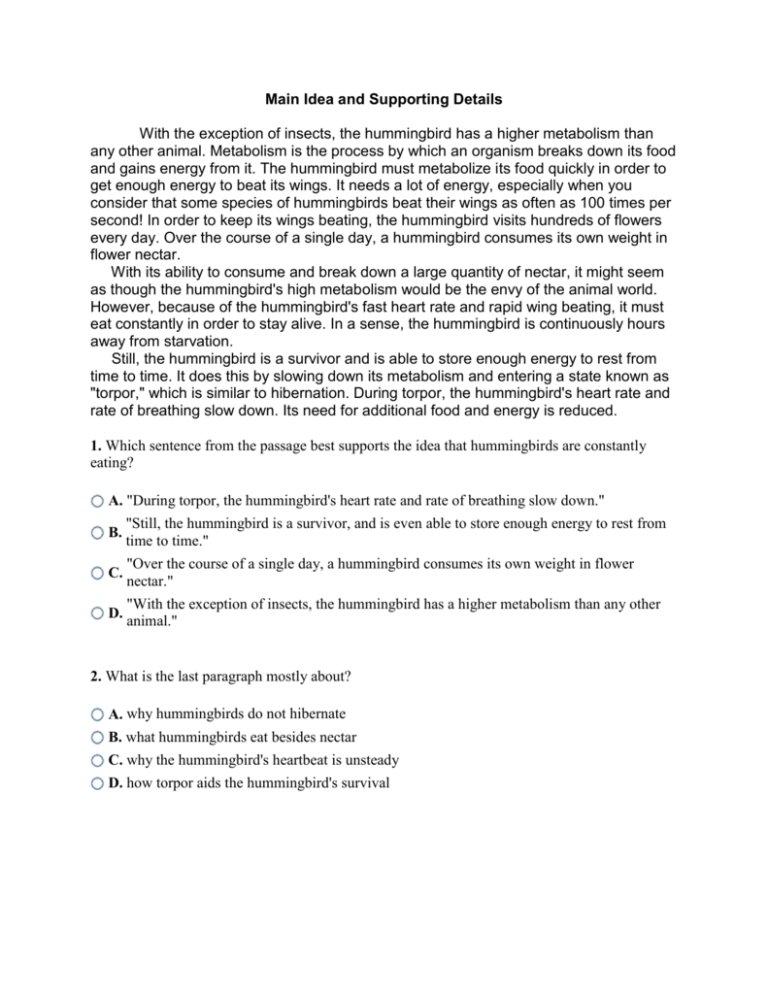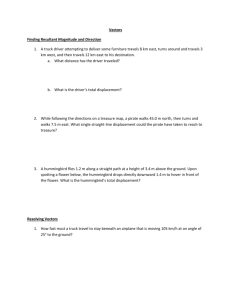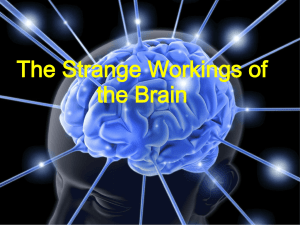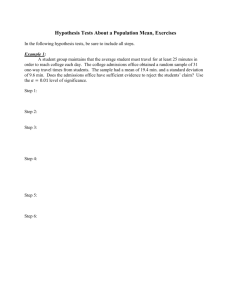Main Idea and Supporting Details With the exception of insects, the
advertisement

Main Idea and Supporting Details With the exception of insects, the hummingbird has a higher metabolism than any other animal. Metabolism is the process by which an organism breaks down its food and gains energy from it. The hummingbird must metabolize its food quickly in order to get enough energy to beat its wings. It needs a lot of energy, especially when you consider that some species of hummingbirds beat their wings as often as 100 times per second! In order to keep its wings beating, the hummingbird visits hundreds of flowers every day. Over the course of a single day, a hummingbird consumes its own weight in flower nectar. With its ability to consume and break down a large quantity of nectar, it might seem as though the hummingbird's high metabolism would be the envy of the animal world. However, because of the hummingbird's fast heart rate and rapid wing beating, it must eat constantly in order to stay alive. In a sense, the hummingbird is continuously hours away from starvation. Still, the hummingbird is a survivor and is able to store enough energy to rest from time to time. It does this by slowing down its metabolism and entering a state known as "torpor," which is similar to hibernation. During torpor, the hummingbird's heart rate and rate of breathing slow down. Its need for additional food and energy is reduced. 1. Which sentence from the passage best supports the idea that hummingbirds are constantly eating? A. "During torpor, the hummingbird's heart rate and rate of breathing slow down." B. "Still, the hummingbird is a survivor, and is even able to store enough energy to rest from time to time." C. "Over the course of a single day, a hummingbird consumes its own weight in flower nectar." D. "With the exception of insects, the hummingbird has a higher metabolism than any other animal." 2. What is the last paragraph mostly about? A. why hummingbirds do not hibernate B. what hummingbirds eat besides nectar C. why the hummingbird's heartbeat is unsteady D. how torpor aids the hummingbird's survival 3. Based on the main idea, which would be the best title for this passage? A. Hummingbirds in Danger of Starvation B. The Torpor of the Hummingbird C. The Highest Metabolism in the Land D. Feasting on Flower Nectar The word synesthesia derives from two Ancient Greek words meaning "together" (syn) and "sensation" (aisthesis). As one might guess from these two meanings, synesthesia is a condition in which two different senses (such as hearing and smell) are combined with one another. There are many different types of synesthesia. One of the most common types happens when a person perceives a letter or number as having a specific color. For example, the person might always associate the number three with the color red, while the number sixteen might always be yellow. In another type of synesthesia, certain days or months might have specific personalities. For example, Tuesday might be a happy day, while the month of May might be melancholy. Additionally, metaphors are sometimes described as "synesthetic," such as when a person describes a shirt as being "loud." It is understood that the shirt doesn't actually make noise; instead, the word "loud" refers to the shirt's color. In this case, the two senses (sight and hearing) are being combined. While synesthesia may seem a strange way to see the world, it can be very helpful for artists. In fact, many artists who do not have synesthesia have attempted to create works of art that capture what it is like to experience synesthesia. 4. What is the main point of the last paragraph? A. Artists sometimes benefit from synesthesia. B. Synesthesia is a strange way to see the world. C. Only people with synesthesia can create art. D. Few great artists truly understand synesthesia. 5. What is the passage mainly about? A. People with synesthesia are unable to hear, see, or smell properly. B. Synesthesia is when a person combines two different senses. C. Certain days or months sometimes have specific personalities. D. Metaphors are combinations of words with hidden meanings. In Zurich, Switzerland, around the time of the outbreak of World War I, a new artistic movement was born. Today we know it as Dadaism. However, the painters, poets, and actors who founded the movement would not have accepted this label. In fact, they might have disagreed that Dadaism was an artistic movement. So what was Dadaism, if not an artistic movement? Above all, it was a reaction to the First World War. The Dadaists felt that the war was proof that the world around them was out of control—even meaningless. In response, they rejected many ideas that people accepted as "normal." Everything for which art stood, Dada represented the opposite. In fact, Dadaists did not call their creations "art;" they called them "anti-art." These creations did not conform to accepted standards of beauty. On the contrary, the Dadaists invented their own standards and rules. The Dadaists intended their work to be a criticism of the war and modern society. However, many people—even artists—did not understand Dadaism and even took offense to it. Today we are able to appreciate Dadaism as a valuable precursor to other artistic movements such as surrealism. Indeed, some art historians cite Dadaism as the very first example of post-modern art. 6. What is the main point of paragraph 3? A. Dadaists have changed since World War I. B. Not everyone agrees about the value of Dadaism. C. Art historians do not understand Dadaism. D. Dadaism has always been extremely popular. 7. Based on the main idea, which would be the best title for this passage? A. Dadaism: Artists in Support of the War B. Dadaism: a Reaction to War C. Dadaism: an Acceptance of Rules D. Dadaism: a Popular Artistic Movement Have you ever had someone tell you a scary story that supposedly happened to "a friend of a friend," and then later heard the exact same story from another, unrelated person? If so, it's a good bet that the story you heard was an urban legend. Urban legends are like folk tales or myths. Often times these legends have been told so many times that it is impossible to determine their origin. The teller of an urban legend may claim that the story happened to a friend. This serves to personalize and enhance the power of the narrative. Since people often exaggerate or change stories when telling them, urban legends can evolve over time. Still, even the most exaggerated urban legends may have a basis in reality. Indeed, this would explain how the story, or legend, became popular in the first place. Another way that urban legends catch on is by depicting horrific crimes or other situations that would affect large populations of people. That way, the people that hear the stories feel compelled to pass them on to their friends and loved ones. One of the classic hallmarks of false urban legends is a lack of specific information. Tellers may be unable to recall the names, dates, or locations of the story. Thus, an astute listener will know to treat the story as entertainment rather than as a serious warning or a reason to panic. 8. Which sentence from the passage supports the idea that tellers of urban legends often leave out important details? A. "One of the classic hallmarks of false urban legends is a lack of specific information." B. "Still, even the most exaggerated urban legends may have a basis in reality." C. "This serves to personalize and enhance the power of the narrative." D. "The teller of an urban legend may claim that the story happened to a friend." 9. Based on the main idea, which would be the best title for this passage? A. Stories About Horrific Crimes Are Lies B. Urban Legends Have No Basis in Reality C. Don't Believe Every Story You Hear D. Stories Provide a Good Reason to Panic To understand how New Orleans became one of the most diverse cities in America, one must learn about its early history. The city was founded on May 7, 1718 as a French colony. It soon established itself as an important trading port. The colony was then ceded to the Spanish Empire in 1763. In 1801, New Orleans reverted again to French control but only for two years. In 1803, Napoleon, who was then the Emperor of France, sold the territory to the United States in the Louisiana Purchase. Thereafter, the city grew rapidly with influxes of Americans, French, Creoles, Irish, Germans, and Africans. Because of New Orleans' prime location as a port on the Gulf of Mexico, the city played a large role in the Atlantic slave trade. At the same time, it had the largest and most prosperous community of free African Americans in the nation. They were often educated and middle-class property owners. In 1872, an African-American man named P.B.S. Pinchback became governor of Louisiana, making him the first non-white governor of a U.S. state. Today, visitors to New Orleans can witness firsthand the cultural diversity that makes the city unique. Locals speak with an accent that cannot be heard elsewhere. It reminds one of the city's French, Spanish, and African influences. Additionally, visitors can still see examples of early French Architecture in the French Quarter. These ornate buildings date back to the 18th Century, when the city was technically under Spanish control. 10. What is the main point of paragraph 4? A. New Orleans' diverse history is evident to visitors today. B. The French and Spanish still have control over parts of the city. C. The English language is rarely spoken by New Orleans' inhabitants. D. The cultures that once made New Orleans unique have left. 11. What is paragraph 3 mostly about? A. the roles that African-Americans played in New Orleans' history B. the advantages of New Orleans' location on the Gulf of Mexico C. how P.B.S. Pinchback became the governor of Louisiana D. the horrible way in which African slaves were treated 12. What is the main idea of this passage? A. Due to its history, New Orleans is a diverse city. B. New Orleans architecture reminds us of its history. C. New Orleans was the first city with a non-white mayor. D. Citizens of New Orleans speak with a French accent.







